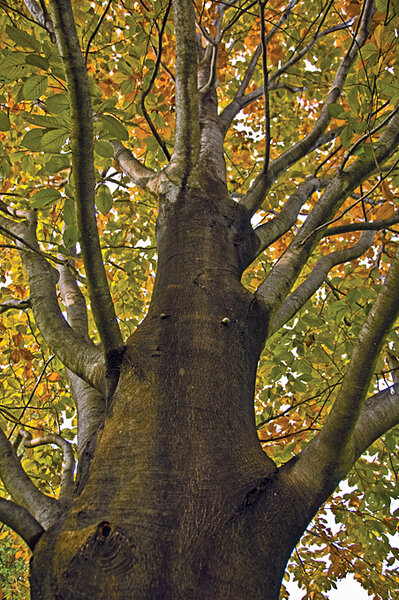A beech tree's last stand
Loading...
The first time I saw the tree was when my husband, Tim, dragged me to look at a run-down house he saw listed on a real estate agent's website. As this was one of his hobbies, I was used to it. It was an icy night and he had to cajole me out of the car. The tree stood off to the side, but I was so distracted by the decrepit nature of the house and Tim's can-do smile that I only glanced at the looming presence, registering Big Tree Off to Left.
Tim's can-do smile turned into a purchase and a 13-month renovation. Well, an overhaul. Most of those 13 months we spent inside tackling tedious decisions like what shade of white we should paint the walls. Neighbors strolled by to check our progress but seemed less interested in the house and more in the fate of the tree. "What's happening with the tree?" asked one. And another, "My kids grew up playing on that tree. I hope you're going to keep it." I sensed a slight nervousness, even hostility, in their questions. Did they think we might cut it down for a driveway, or maybe even a three-car garage?
I added these perceived reproaches to the many reasons why I thought we had made a mistake buying this house. Stuffy town, nosy neighbors. I hoped that if I accumulated enough complaints we might finally pack up and leave Massachusetts, returning to New York City. I had been perfectly content in our Upper West Side building with 49 apartments and neighbors to chat with in the elevator. OK, not the crazy lady with all of the cats. But, with more than 10 children our children's ages, we never wanted for play-dates or community. And trick-or-treating was so efficient.
After a few visits from our Cambridge neighbors, I decided to look closer at this tree. It was a beech, taller than our three-story house, and its canopy shaded the whole south side of our yard. Limbs grazed one neighbor's roof and aimed for another across the street. One branch dipped to the ground and curved back up, forming an elongated U. The trunk measured more than four feet in diameter and the root crown reminded me of elephant toes. The silvery blue-gray bark resembled cracked leather. The leaves were light and feathery, like ferns.
I stood next to the trunk and looked up. Aside from my visit to see California redwoods in Muir Woods, I had never seen such majesty. This was one serious tree, or as someone later commented, "one, big, beautiful plant." And – gulp – it was on our property. Big responsibility.
Shortly thereafter, we moved in. The tree became our mecca. My kids were glued to the swings that we hung from its branches. Neighborhood kids clambered over it. Everyone in our small community had a story about it – losing a ball in the fallen leaves, carving initials into the trunk. Or they had a nickname for it – the dragon tree, the elephant tree.
One afternoon, two years later, I found a piece of bark lying on the ground near the trunk. Over the next couple of months, a few more pieces fell. I called an arborist to take a look. His diagnosis was cautionary. The tree was stressed and needed deep watering and fertilizing.
We did everything he suggested, but bark continued to shed. For the next two years, we nursed the tree while other arborists paraded through and prescribed additional treatments.
Over time, whole sheets of bark began falling. And then, entire branches withered. Eventually, half of the tree was dead. The other half, facing our house, was struggling in a last, desperate gasp. Every square inch was teeming with tuftlike greenery, like a rain forest.
An arborist delivered the dreaded news. He told us the tree wasn't safe; we needed to cut it down. That night, unable to sleep, I wandered into the hallway and found my daughter awake. We tiptoed to the window to look at our beloved beech.
For the next couple of weeks, my family couldn't shake its grief. Life without the beech seemed unimaginable. How could it have died on our watch? Had we loved it too much? Done something wrong?
A week before the fated Tuesday, Bill from next door interviewed me about the tree's decline. He videoed the wormholes, beetle infestation, and rot and e-mailed it to our neighborhood listserv. On Sunday, we hosted a goodbye party. Thirty neighbors gathered around the beech for the last time. There were people I had never met or even seen before. Our reclusive neighbor across the street showed up. A family with a days' old baby took its first outing. Bill shot another video for those who couldn't come.
Tuesday morning arrived with a crane and a lot of saws. A group of us stood vigil as the lumberjack felled the tree limb by limb. At the end of the day, all that remained was its massive stump, stacks of firewood, and piles of sawdust. That evening we sat on Bill's porch facing where the beech used to be. We stayed until it was dark.
Somehow through the dying of our tree, I began to let go of New York. I got to know my neighbors. There was a huge hole where the tree had been, but I didn't want to live anywhere else anymore. Bill made one final video, of the tree coming down. It ended with a postscript, "Before the tree came down, we felt the loss. Now we're surprised by how much we feel the light."





